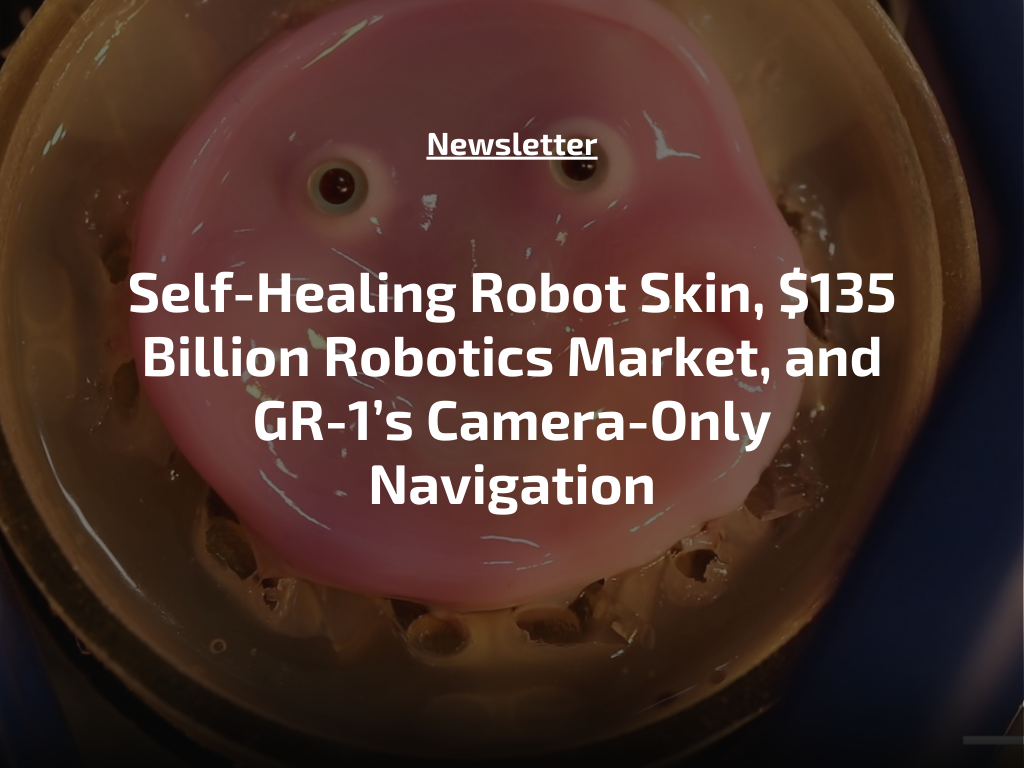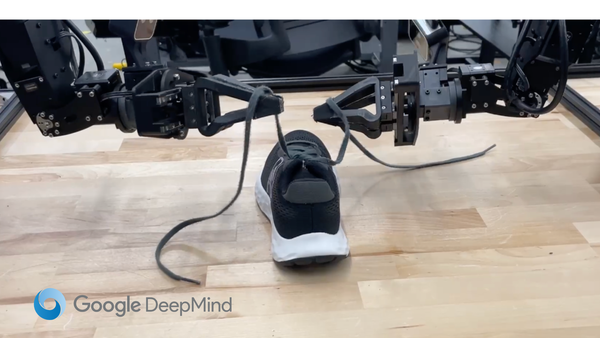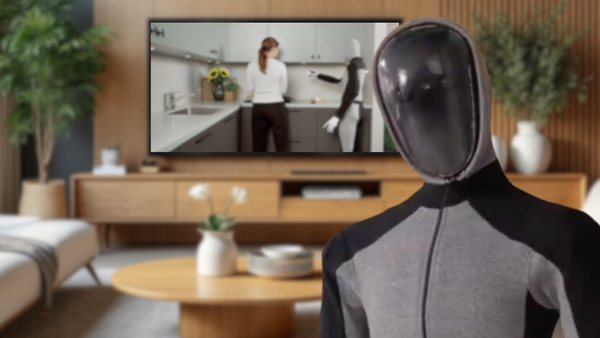Self-Healing Robot Skin, $135 Billion Robotics Market, and GR-1’s Camera-Only Navigation
Discover the latest in robotics with the projected $135 billion market boom, the development of self-healing artificial skin for robots, and the GR-1 humanoid’s innovative vision-only navigation system.

Good morning! What a fantastic week for humanoids. Our first story is a bit creepy but kind of cool, too. We’re going to explore groundbreaking research in self-healing artificial skin.
The next two stories focus on the projected growth of robotics driven by warehouse automation and Fourier Intelligence's GR-1 humanoid robot, which uses multi-camera vision to navigate.
Let's dive in...
Self-Healing 'Living Skin' Makes Robots More Humanlike
Researchers have developed a new type of self-healing "living skin" for robots that mimics human skin's elasticity and repair capabilities.
This novel approach, involving cultured skin cells and silicone, addresses the challenges of making artificial skin appear lifelike and securely attached to robotic frames. The findings were published in the journal Cell Reports Physical Science.
WHAT YOU NEED TO KNOW
- Self-Healing Capability: Like human skin, artificial skin can repair itself from cuts or scrapes, reducing the need for manual repairs and enhancing the robot's durability in human environments.
- Advanced Attachment Method: The new method uses tiny holes in the robot's skeleton, allowing the skin to attach securely with "perforation-type anchors." This prevents sagging and maintains a smooth, flexible surface.
- Lifelike Appearance and Function: The skin's realistic elasticity allows robots to mimic human expressions, such as smiling, making them more relatable and functional in various applications.

WHY YOU SHOULD CARE
- Enhanced Human-Robot Interaction: This innovation brings robots closer to appearing and behaving like humans, potentially improving their acceptance and integration into everyday life, from personal assistants to healthcare providers.
- Durability and Maintenance: The artificial skin's self-repairing feature means that robots can operate longer and more efficiently without frequent maintenance, making them more practical for continuous use in diverse environments.
- Future Technological Advancements: This research advances robotics and has potential implications for medical fields, such as surgery and prosthetics, by improving our understanding of skin mechanics and developing better materials for human use.
Source: Live Science
135.68 Billion Warehouse Automation Boom Drives Robotics Market by 2031
The robotics market is experiencing significant growth, projected to reach $135.68 billion by 2031, driven by logistics and warehouse automation expansion.
With a current market size of $34.06 billion in 2022, the sector is expected to grow at a CAGR of 16.60% from 2024 to 2031. Increasing demand for automation in manufacturing and the rise of Industry 4.0 are key factors propelling this growth.
WHAT YOU NEED TO KNOW
- Investment Surge: Significant investments are pouring into the robotics sector, with companies like Hyundai investing $400 million in Boston Dynamics AI Institute to advance AI and robotics, and the International Federation of Robotics reporting increased demand due to new car manufacturing plants and modernization of industrial facilities.
- Industry 4.0 and Digitization: Integrating robotics with Industry 4.0 technologies, such as AI and machine learning, is transforming manufacturing processes. Partnerships like Siemens and Google Cloud's collaboration to integrate AI with factory automation highlight this trend.
- Robotics in Healthcare and Logistics: The healthcare segment, holding 26.72% of the market share, and the rapidly evolving logistics sector are leading the adoption of robotics. Service robots in healthcare are improving patient care and surgical precision, while logistics robots are enhancing efficiency in order fulfillment and warehouse management.

WHY YOU SHOULD CARE
- Technological Advancements: The shift towards advanced robotics and AI integration in industries is revolutionizing manufacturing, healthcare, and logistics, offering new opportunities for efficiency and innovation.
- Economic Impact: The increasing adoption of robotics in critical sectors like healthcare and logistics is driving significant economic growth, reducing labor costs, and addressing labor shortages, making it a crucial area for investment and development.
- Global Competitive Landscape: With significant investments and technological advancements led by companies in the US, China, and Japan, staying informed about these trends is essential for maintaining a competitive edge in the global market. Understanding these dynamics can help businesses and investors strategically navigate and capitalize on the burgeoning robotics industry.
Source: SkyQuest
The GR-1 Humanoid Uses Multi-Camera Vision Instead of Complex Sensor Suites
Fourier Intelligence's GR-1 humanoid robot now features a multi-camera vision system instead of more expensive and complex sensor suites like radar and LiDAR. The GR-1 is equipped with six RGB cameras for a 360-degree view.
Using a neural network, it generates 3D spatial features, allowing it to navigate environments accurately. This approach reduces hardware costs and enhances the robot's environmental perception, resulting in safer and more efficient operations.
WHAT YOU NEED TO KNOW
- Vision-Only Navigation: The GR-1 uses six RGB cameras for a comprehensive 360-degree view, creating a bird's-eye-view map and a 3D occupancy grid to navigate its surroundings efficiently, similar to Tesla's vision-based Autopilot system.
- Advanced Capabilities: The GR-1 boasts 54 degrees of freedom, high-def display, audio capabilities, and advanced AI, including a "ChatGPT-like" language model for natural language processing and logical reasoning, enhancing its versatility across different applications.
- Real-World Applications: Designed for diverse uses such as medical rehabilitation, family services, security inspection, and industrial manufacturing, the GR-1's vision system enables real-time obstacle detection and collision avoidance, demonstrating high efficiency and accuracy.
WHY YOU SHOULD CARE
- Cost-Effective Innovation: By opting for a vision-only navigation system, Fourier Intelligence significantly reduces hardware costs while maintaining high environmental perception and operational efficiency, setting a new standard for cost-effective robotics.
- Enhanced Versatility: Integrating advanced AI and natural language processing capabilities allows the GR-1 to perform tasks with human-like precision, making it a versatile tool in various sectors, from healthcare to industrial settings.
- Future of Robotics: The GR-1's successful implementation of a multi-camera vision system and its potential applications highlight the growing importance of embodied AI in robotics, influencing future developments and deployments in the field. Understanding these innovations can provide valuable insights into the direction of humanoid robot technology and its impact on different industries.
Source: New Atlas



